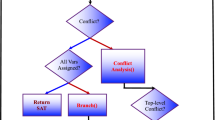Abstract
In this paper we describe an interior point mathematical programming approach to inductive inference. We list several versions of this problem and study in detail the formulation based on hidden Boolean logic. We consider the problem of identifying a hidden Boolean functionℱ:{0, 1}n → {0, 1} using outputs obtained by applying a limited number of random inputs to the hidden function. Given this input—output sample, we give a method to synthesize a Boolean function that describes the sample. We pose the Boolean Function Synthesis Problem as a particular type of Satisfiability Problem. The Satisfiability Problem is translated into an integer programming feasibility problem, that is solved with an interior point algorithm for integer programming. A similar integer programming implementation has been used in a previous study to solve randomly generated instances of the Satisfiability Problem. In this paper we introduce a new variant of this algorithm, where the Riemannian metric used for defining the search region is dynamically modified. Computational results on 8-, 16- and 32-input, 1-output functions are presented. Our implementation successfully identified the majority of hidden functions in the experiment.
Similar content being viewed by others
References
D. Angluin and C.H. Smith, “Inductive inference: Theory and methods,”Computing Surveys 15 (1983) 237–265.
E. Boros, P.L. Hammer and J.N. Hooker, “Predicting cause-effect relationships from incomplete discrete observations,” RUTCOR, Rutgers University (Piscataway, NJ, 1991).
R.K. Brayton, G.D. Hachtel, C.T. McMullen and A.L. Sangiovanni-Vincentelli,Logic Minimization Algorithms for VLSI Minimization (Kluwer Academic Publishers, Dordrecht, 1985).
D.W. Brown, “A state-machine synthesizer-SMS,” in:Proceedings of the 18th Design Automation Conference (1981) pp. 301–304.
Y. Crama, P.L. Hammer and T. Ibaraki, “Cause-effect relationships and partially defined Boolean functions,”Annals of Operations Research 16 (1988) 299–325.
M. Davis and H. Putnam, “A computing procedure for quantification theory,”Journal of the ACM 7 (1960) 201–215.
J.F. Gimpel, “A method of producing a Boolean function having an arbitrarily prescribed prime implicant table,”IEEE Transaction on Computers 14 (1965) 485–488.
S.J. Hong, R.G. Cain and D.L. Ostapko, “MINI: A heuristic approach for logic minimization,”IBM Journal of Research and Development (1974) 443–458.
A.P. Kamath, N.K. Karmarkar, K.G. Ramakrishnan and M.G.C. Resende, “Computational experience with an interior point algorithm on the Satisfiability problem,”Annals of Operations Research 25 (1990) 43–58.
N. Karmarkar, “An interior-point approach to NP-complete problems,”Contemporary Mathematics 114 (1990) 297–308.
N. Karmarkar, “Riemannian geometry underlying interior-point methods for linear programming,”Contemporary Mathematics 114 (1990) 51–75.
N.K. Karmarkar, M.G.C. Resende and K.G. Ramakrishnan, “An interior point algorithm to solve computationally difficult set covering problems,”Mathematical Programming 52 (1991) 597–618.
N.K. Karmarkar, M.G.C. Resende and K.G. Ramakrishnan, “An interior-point approach to the maximum independent set problem in dense random graphs,” in:Proceedings of the XV Latin American Conference on Informatics (1989) pp. 241–260.
E.J. McCluskey, “Minimization of Boolean functions,”Bell System Technical Journal 351 (1956) 417–1444.
R.E. Miller,Switching Theory, Vol. 1: Combinatorial Circuits (Wiley, New York, 1965).
J.J. Moré and D.C. Sorensen, “Computing a trust region step,”SIAM Journal on Scientific and Statistical Computing 4 (1983) 553–572.
E. Morreale, “Recursive operators for prime implicant and irredundant normal form determination,”IEEE Transactions on Computers C-19 (1970) 504.
R. Pai, N. Karmarkar and S.S.S.P. Rao, “A global router based on Karmarkar's interior point method,” CSE, Indian Institute of Technology (Bombay, 1988).
W.V. Quine, “The problem of simplifying truth functions,”American Mathematical Monthly 59 (1952).
W.V. Quine, “A way to simplify truth functions,”American Mathematical Monthly 62 (1955).
J.P. Roth, “A calculus and an algorithm for the multiple-output 2-level minimization problem,” IBM Thomas J. Watson Research Center (Yorktown Heights, NY, 1968).
R. Rudell and A. Sangiovanni-Vincentelli, “Exact minimization of multiple-valued functions for PLA optimization,” in:Proceedings of the IEEE International Conference on Computer-Aided Design (1986) pp. 352–355.
B. Selman, D. Mitchell and H.J. Levesque, “A new method for solving large Satisfiability problems,” AT&T Bell Laboratories (Murray Hill, NJ, 1991).
J.R. Slagle, C.L. Chang and R.C.T. Lee, “A new algorithm for generating prime implicants,”IEEE Transactions on Computers C-19 (1970) 304.
E. Triantaphyllou, A.L. Soyster and S.R.T. Kumara, “Generating logical expressions from positive and negative examples via a branch-and-bound approach,” Industrial and Management Systems Engineering, Pennsylvania State University (University Park, PA, 1991).
Y. Ye, “On the interior algorithms for nonconvex quadratic programming,” Integrated Systems Inc. (Santa Clara, CA, 1988).
Author information
Authors and Affiliations
Rights and permissions
About this article
Cite this article
Kamath, A.P., Karmarkar, N.K., Ramakrishnan, K.G. et al. A continuous approach to inductive inference. Mathematical Programming 57, 215–238 (1992). https://doi.org/10.1007/BF01581082
Received:
Revised:
Issue Date:
DOI: https://doi.org/10.1007/BF01581082




